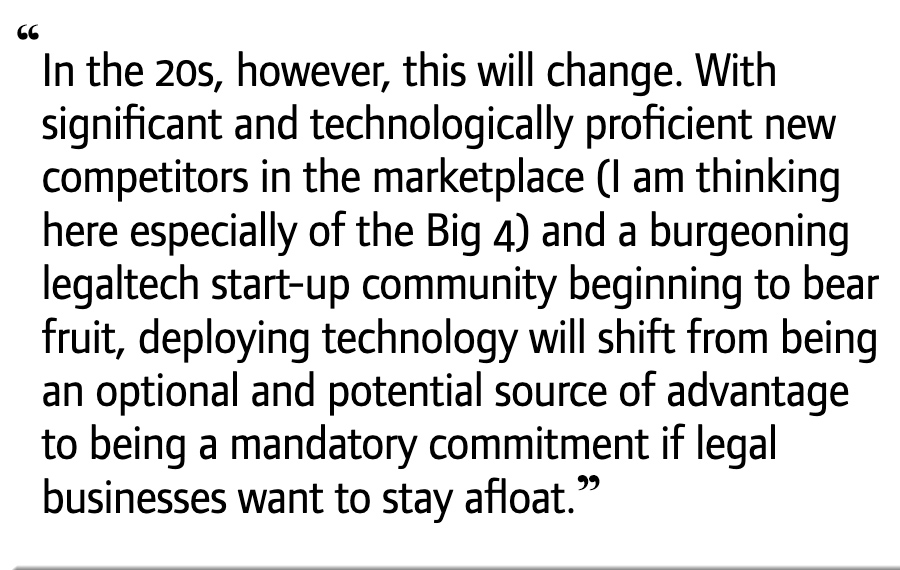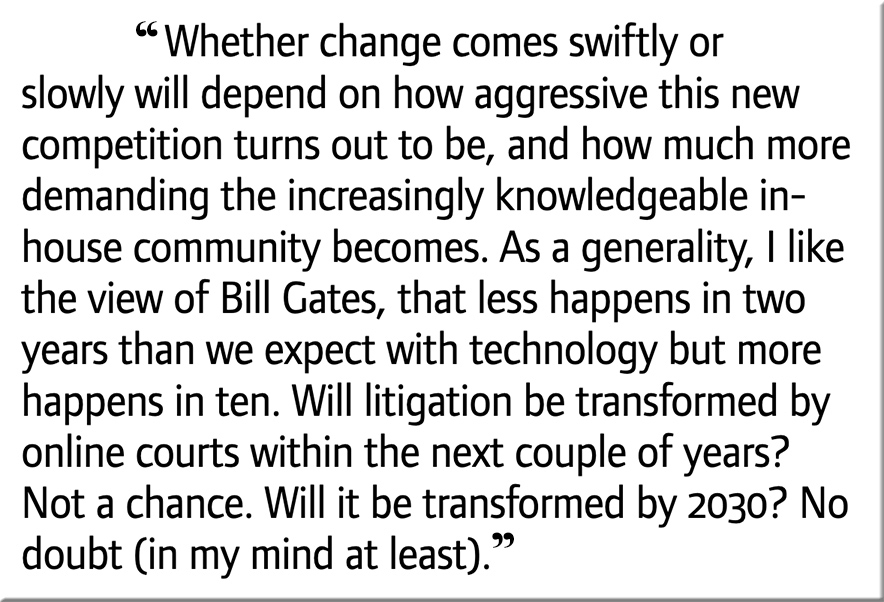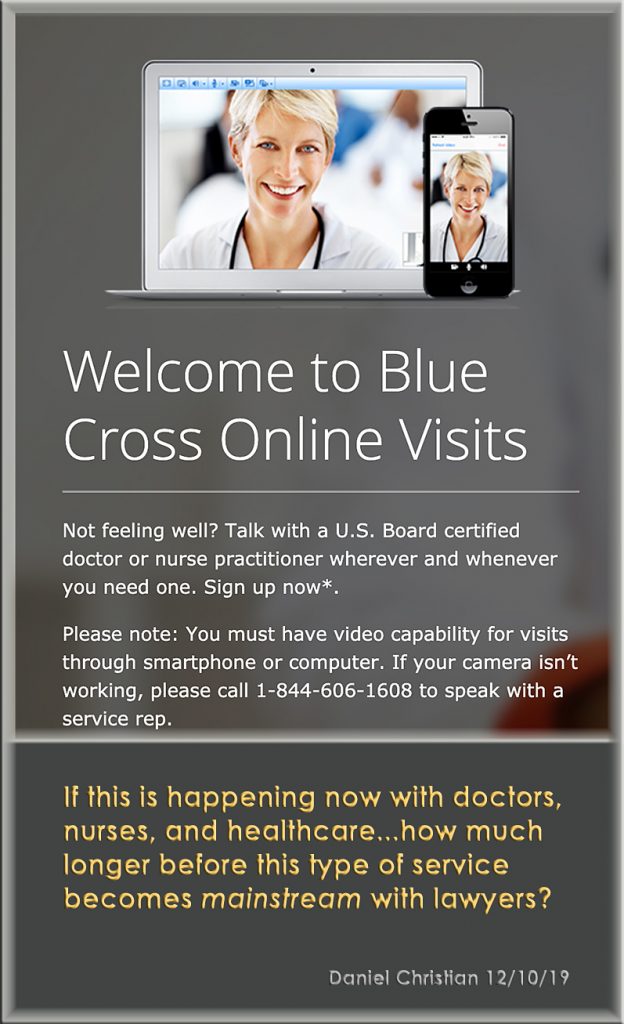Excerpts:


How AI is disrupting the legal tech industry — from itproportal.com by Derek Chau
Law firms will benefit from a growing ability to deliver high-value, strategic services while leveraging the ability of AI to execute lower value tasks.
Excerpt:
As increasingly complex AI solutions emerge, the technology continues to capture imaginations across the legal community. AI has become a catalyst for change within the legal ecosystem. And as platforms become more sophisticated, companies have begun to tap into ever-expanding automation and scalability.
Potential impacts/applications include:
This reality is driven by the democratisation of legal services as a result of AI integrations. The movement is poised to lower the costs associated with corporate transactions, legal research, IP transactions, and related services. As such, law firms will benefit from a growing ability to deliver high-value, strategic services while leveraging the ability of AI to execute lower value tasks.

From DSC:
Along these lines, we’ll likely see more bots and virtual legal assistants that we will be able to ask questions of.
#A2J #AccessToJustice #legal #lawyers #society #legaltech #bots #videoconferencing #AI #bots #VirtualAssistants
Along these lines, also see:
Innovative and inspired: How this US law school is improving access to justice — from studyinternational.com
Excerpt:
Though court and other government websites in the US provide legal information, knowing what to search for and understanding legal jargon can be difficult for lay people.
Spot, software that is being developed at the LIT Lab, aims to fix this.
“You know you have a housing problem. But very few people think about their housing problems in terms of something like constructive eviction,” explains David Colarusso, who heads the LIT Lab. “The idea is to have the tool be able to spot those issues based upon people’s own language.”
Developed by Colarusso and students, Spot uses a machine-based algorithm to understand legal queries posed by lay persons. With Spot, entering a question in plain English like “My apartment is so moldy I can’t stay there anymore. Is there anything I can do?” brings up search results that would direct users to the right legal issue. In this case, the query is highly likely to be related to a housing issue or, more specifically, to the legal term “constructive eviction.”
Lastly, here’s an excerpt from INSIGHT: What’s ‘Innovative’ in BigLaw? It’s More Than the Latest Tech Tools — from news.bloomberglaw.com by Ryan Steadman and Mark Brennan
Top Innovation Factors for Success
Before revving the engines in the innovation process, the safety check comes first. Successful innovation requires a deliberate, holistic approach that takes into consideration people, process, and technology. Firms and vendors that listen and learn before implementing significant change will stand apart from competitors—and help ensure long-term success.
TECHREPORT 2019: Practice Management — from lawtechnologytoday.org by Alexander Paykin
Excerpt (emphasis DSC):
The American Bar Association’s Legal Technology Resource Center surveyed a sample size of 53,252 attorneys regarding the technology and software both available and utilized in their firms. This TECHREPORT analyzes both the responses of these attorneys on a variety of technological developments and changes occurring in the legal industry and the existing trepidation to adopt certain technologies.
…
The world continues to shift towards a more technological focus, while the legal industry has not followed suit in many aspects. The use of practice management systems has not seen any real growth throughout the last four years despite high satisfaction ratings. There still remains a need for an all-inclusive practice management system that would not require firms to purchase a variety of different programs for specific tasks, and the switching costs of practice management systems remain a concern for many firms—particularly solo and large firms.
…
Overall, technology continues to be developed for the legal industry in abundance, however, in many sectors of the industry, various sized firms are hesitant to adopt these advancements, leading to steady or declining growth rates for much of these technologies. The size of the firm also has a large influence on the technologies a firm may adopt, and this makes it hard to predict what technologies may appeal to what firms.
Most law technology is still fairly new, and it has quite far to go before being developed enough to displace traditional ways of accomplishing tasks that many firms value now. There still exists a desire for more and newer technologies that will make this switch easier, and without the feasibility to switch to these software programs more efficiently and effectively, the legal industry will still wait to adapt to the evolving technological world around us.
Report: College leaders not confident they can beat new competition — from educationdive.com by Hallie Busta, with thanks to Ray Schroeder for posting this out on LinkedIn
Excerpt:
While they say their institutions are prepared to meet students’ changing needs, they are less confident in their ability to address new forms of competition or change how the public views higher ed.
…
The report comes as higher ed stares down potentially fewer traditional students, more competition online, less state funding, and concerns over public perceptions of higher ed. These pressures have made smaller public and private institutions vulnerable to consolidation and even closure.
The Global Landscape of Online Program Companies — from by Doug Lederman
New trove of data suggests a bigger, more complex, more varied ecosystem of companies that work with colleges to take their academic programs online.
Excerpt:
A new dataset promises to give college leaders, company officials and others involved in the online learning landscape much more information about who offers what programs, how they manage them and where the money is flowing, among other factors.
And the company behind the new data, Holon IQ, published a report today that gives a new name to the large and diversifying category of providers that are working with colleges to take their programs online: OPX, instead of OPM, for online program management companies. (More on that later.)
Also see:
Also see:
Digital workplaces are the future for the legal industry — from abovethelaw.com by James Lo
The speed of business is accelerating, and digital workplaces are answering the demand for a better way to work, by providing a single platform to manage content, people, and applications.
Excerpt:
The consumerisation of enterprise technology has led to an increasing expectation from lawyers, clients, and business users alike that the legal technology they are using in the workplace for collaboration, knowledge management, transaction management, and more should be as useful, intuitive, and user-friendly as what they are already using at home on a day-to-day basis.
Digital workplaces are answering the demand for a better way to work, by providing a single platform to manage content, people, and applications. As law firms review their technology strategy for the next three to five years, there is an opportunity to create digital workplaces that will match how lawyers will want to work in the future. Within a digital workplace, a lawyer will have access to relevant data and content, collaborate with both clients and colleagues, share knowledge, and solve problems, all in real-time, from anywhere.
At the same time, clients are expecting firms to be using data, artificial intelligence and other technologies to predict outcomes, reduce costs, improve transparency and ultimately add value.
The Adaptable Organization Series: Part 5: The Ecosystem — from capitalhblog.deloitte.com; posted by Don Miller and Tiffany McDowell
Excerpt:
In an Adaptable Organization, understanding the external environment becomes a continuous activity that fuels constant efforts to evolve the business.
Encouraging people to constantly sense the external environment helps people inside the organization to be open about what they are seeing and how they believe it will impact the organization.
It is a stark contrast to the “set it and forget it” strategy and organizational design that traditionally occurred every three to five years.
Yet this expansive system can easily become misaligned and requires a greater purpose to remain connected.
A shared purpose connects the ecosystem; defines success through the eyes of customers, stakeholders and society; and helps motivate people to succeed. Not only are Adaptable Organizations able to respond quickly to changes, but they also take their role as a social enterprise seriously, moving away from being solely a “business enterprise.” These organizations aim to engage and connect with the hearts and minds of their workers, customers, communities, and societies-at-large. Adaptable Organizations are grounded in social purpose and bring teams on a journey while responding to changes with agility, speed, and ease.
A shared purpose holds the ecosystem together. Direction is given from the shared purpose and not from an organizational hierarchy. By bringing a purpose statement to life and connecting the dots for workers through storytelling and meaningful narratives, workers are more likely to commit to the organization’s strategy and execution.